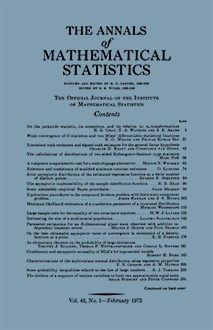Abstract
The importance of the theory of Latin squares and mutually orthogonal Latin squares is due to the fact that many well-known experimental designs and/or combinatorial systems are either equivalent or can be derived from Latin squares or sets of mutually orthogonal Latin squares; viz., balanced incomplete block designs, partially balanced incomplete block designs, group divisible designs, $F$-square designs, lattice designs, balanced weighing designs, orthogonal arrays, Hadamard matrices, affine planes, projective planes, partial geometries, nets, error correcting codes, strongly regular graphs and many more designs and combinatorial systems (see [7] for more details). The problem of determining whether or not a set of $r$ mutually orthogonal Latin squares of order $n$, say an $O(n, r)$ set, can be embedded in a larger set of $t$ mutually orthogonal Latin squares of order $n$, is one of the many important problems in the theory of mutually orthogonal Latin squares. An obvious and interesting problem in the area of embedding is to find a necessary and sufficient condition under which an $O(n, r)$ set can be embedded in an $O(n, t)$ set for $1 \leqq r < t \leqq n - 1$, where by an $O(n, 1)$ set we mean a set consisting of a single Latin square of order $n$. Some of the principal published results on embedding are discussed below. Mann [9] proved that if a Latin square $L$ is of order $n = 4t + 2$ (or alternatively $4t + 1$) with a subsquare of order $2t + 1$ (or $2t$) in which all entries are from a set of $2t + 1$ (or $2t$) numbers except for possibly $t$ (or $\lbrack t - \frac{1}{2}\rbrack$) or less of the cells, then $L$ cannot be embedded in an $O(n, 2)$ set. Thus, Mann's embedding conditions depend upon the value of $n$ and the combinatorial structure of $L$. Parker [11] proved that if the $O(n, r)$ set $S$ contains a sub $O(r + 1, r)$ set, then $S$ can be embedded in an $O(n, r + 1)$ set only if $n = (r + 1)^2$ or $n \geqq (r + 1)(r + 2)$. These embedding conditions depend upon $r, n$, and the combinatorial structure of the set $S$. Shrikhande [15] proved that any $O(n, n - 3)$ set $S$ can be embedded in an $O(n, n - 1)$ set for all $n > 4$. His result does not require any knowledge about the combinatorial structure of the set $S$. Bruck [2], who generalized Shrikhande's [15] results to some extent, utilized net theory to show that any $O(n, n - 1 - d)$ set $S$ can be embedded in an $O(n, n - 1)$ set regardless of the combinatorial structure of $S$ provided that $n > (d - 1)(d^3 - d^2 + d + 2)/2$. Utilizing the above results and some group theory, some new results have been found for embedding $O(n, r)$ sets in $O(n, t)$ sets, $r < t$. The results are presented in the form of several theorems, propositions and corollaries. The first proposition is concerned with a necessary and sufficient condition for embedding $O(n, 2)$ sets in $O(n, 3)$ sets. Theorem 3.1 gives a sufficient condition for embedding an $O(n, 1)$ set in an $O(n, \lambda)$ set, $2 \leqq \lambda \leqq$ smallest prime in the prime power decomposition of $n$, less one. Theorem 3.2 states the conditions under which the method of Theorem 3.1 fails for embedding certain $O(n, 1)$ sets in a larger set. The next theorem states the conditions under which certain $O(n, 1)$ sets cannot be embedded in a larger set. Some results on properties of inverses of Latin squares and on products have also been presented. Additional results in this paper are embodied in Theorem 3.4 and relate to the enumeration of Latin squares of order $n$ for those Latin squares which have orthogonal mates and for those which do not have an orthogonal mate. Theorem 3.4 gives a lower bound for $n$ even (odd) on the number of Latin squares of degree one (at least degree two). All Latin squares of order 2, 3, 4, 5, 6 and 7 are classified with respect to degree of orthogonality.
Citation
A. Hedayat. W. T. Federer. "On Embedding and Enumeration of Orthogonal Latin Squares." Ann. Math. Statist. 42 (2) 509 - 516, April, 1971. https://doi.org/10.1214/aoms/1177693401
Information





